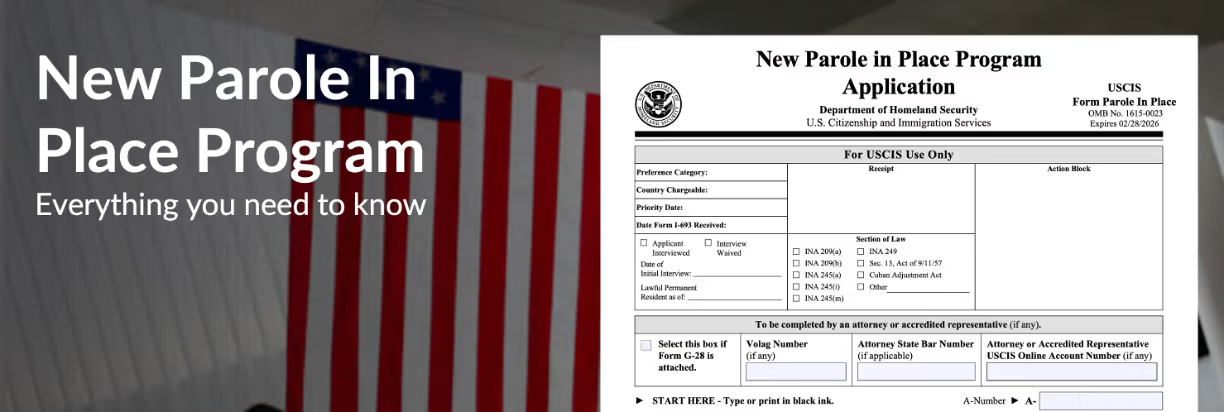Parole in Place Program: What You Need to Know
On November 7, 2024, a federal district court in Texas struck down the Biden Administration’s Keeping Families Together parole in place program. The ruling comes after the court’s earlier temporary halt to the program. The Biden Administration may appeal the decision. We will provide an update once more information is available.

The new Parole in Place (PIP) program is launching this summer, providing a pathway for certain undocumented immigrants to remain in the United States legally. The program was just announced but it you might have the following questions:
- What are the requirements for Parole in Place?
- How do I apply for Parole in Place?
- What documents do I need to apply for Parole in Place?
- How long will it take for my Parole in Place application to be approved?
- With Parole in Place can I apply for a Green Card?
USCIS has not released information on some of those questions but in this article we will walk you through two specific and important questions: What are the Requirements for Parole in Place and What Documents Do I Need for Parole in Place?o be eligible, applicants must meet specific requirements. We will tell you everything you need to know.
We will walk you through each of the requirements and then each of the documents that you can submit to show that you are eligible for each requirement.
Parole in Place Eligibility Requirements

- Current Presence in the United States Without Admission or Parole: You must currently be in the U.S. without having been formally admitted or paroled into the country.
- Continuous Presence in the United States for at Least 10 Years as of June 17, 2024: You must have lived in the U.S. continuously for at least 10 years by June 17, 2024.
- Legally Valid Marriage to a U.S. Citizen or Qualifying Stepchild of a U.S. Citizen as of June 17, 2024: You must be married to a U.S. citizen or be a qualifying stepchild of a U.S. citizen as of this date.
- No Disqualifying Criminal History or Threat to National Security/Public Safety: You must have a clean criminal record and pose no threat to national security or public safety.
Documents Needed to Apply for Parole in Place: Supporting Evidence

To prove your eligibility, you will need to provide various documents. Here’s how you can show you meet each requirement:
1. Continuous Residence in the US for Ten Years
- Lease Agreements or Mortgage Statements for the Past Ten Years: These documents show where you have lived and for how long.
- Bank Statements Showing Regular Transactions Over the Past Ten Years: Regular transactions on bank statements can show that you have been living and working in the U.S. continuously.
- Employment Records, Including Pay Stubs and W-2 Forms, for the Past Ten Years: These documents prove your work history and can show a continuous presence in the country.
- School Records for Any Children Listing the Parent and Address of Records: If your children have been attending school, their records can provide proof of your continuous residence.
- Medical Records Showing the Applicant's Name and Address Over the Past Ten Years: Regular medical visits documented in medical records can help prove your presence in the U.S.
- Insurance Policies (Health, Auto, Home) Listing the Applicant's Name and Address: These policies can show that you have been maintaining insurance in the U.S., indicating continuous residence.
- Income Tax Returns Filed for the Past Ten Years: Filing taxes regularly can be strong evidence of your presence and work history in the U.S.
- Affidavits from Neighbors, Landlords, or Community Members: Signed statements from people in your community who can attest to your residence over the past ten years can also be very helpful.
2. Proof of a Lawful Marriage to a US Citizen Spouse
- Marriage Certificate: This is the primary document that proves you are legally married.
- Joint Bank Account Statements: These can show that you share financial responsibilities with your spouse.
- Joint Utility Bills: Utility bills in both names show that you live together.
- Joint Lease or Mortgage Documents: These documents can prove that you live together and share housing costs.
- Joint Tax Returns: Filing taxes together shows financial unity and a valid marriage.
- Birth Certificates of Any Children Born to the Couple: These can further show the legitimacy of your marriage.
3. Proof of the Spouse's US Citizenship
- US Birth Certificate: This shows that your spouse was born in the United States and is a citizen.
- Certificate of Naturalization: If your spouse became a U.S. citizen through naturalization, this certificate will prove their status.
- Certificate of Citizenship: This can be used to prove your spouse's citizenship if they were born abroad to U.S. citizen parents.
- Consular Report of Birth Abroad: This document shows that your spouse was born abroad to U.S. citizen parents and is therefore a U.S. citizen.
- US Passport: A valid U.S. passport is strong evidence of U.S. citizenship.
These documents are examples of some of the evidence that will help make sure that you have a strong application that can potentially avoid any delays from USCIS processing. Like all US immigration applications, it is important to submit all of the required documents and following these examples will help you build a strong case for your eligibility for the Parole in Place program. Make sure to keep your records organized and submit copies of everything required. Want to learn more about the Parole in Place program? Check out this Fact Sheet Published by the US Department of Homeland Security.
Get A Head Start on PIP
By gathering these types of documents now you will be well prepared to start filling out your PIP application as soon as USCIS releases details and makes the application process available later this summer. Thanks for your interest in SimpleCitizen. We make the immigration process simple. We’re happy you’re here!
Stay Updated

As the government announces more details about these policy changes we’ll keep you updated. Sign-up below to receive emails and helpful information from us as it becomes available.
Sign Up for Updates on the PIP Program
Your Full Name:
Your email:
By checking this box you consent to receive update emails from SimpleCitizen. We promise we will not SPAM you.
Send
Related
U.S. Immigration News
Articles
Begin Your Immigration Journey Today with SimpleCitizen!
Why spend more time and money on countless legal headaches, when you could just use SimpleCitizen and focus on what matters most – being with those you love! Find new opportunities, start new adventures, and bring your family together with SimpleCitizen today!

